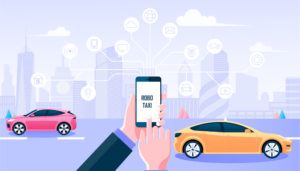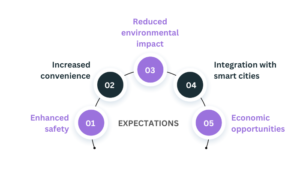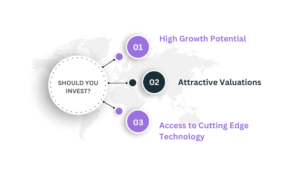Technology has changed the landscape of ride-hailing services; RoboTaxi App is what you can expect next from Uber.
It’s again in the game of Robotaxi services, Uber is not the only one who is testing self-driving cars; popular companies like Apple, Tesla, and Google are in the race.
Now the first thing that comes to mind is what Uber is doing among the ranks of such high-powered engineering firms.
So first of all, Uber has come a long way to argue that it is merely a ride-sharing platform. No doubt it has the potential to link users with independent drivers.
Now the question is if Uber succeeds in developing self-driving cars who are going to provide ride-hailing services? Of Course Robots.
With this, revenue in the ride-hailing & taxi segment is projected to reach US 41.78 Bn in 2023. When it comes to global comparison, China will be generating most of the revenue of US$ 130.90 Bn in 2023.
Despite of competition, when it comes to RoboTaxi App, it’s not tough competition for China as DiDi is dominating the taxi market of China like Uber.
But uber robotaxi can give tough competition to DiDi, so if you want to invest in online Taxi booking app development. Now is the right time to invest in.
With the RoboTaxi app, the concept of hailing a self-driving car becomes a reality, revolutionizing the way we travel.” – Travis Kalanick, Co-founder of Uber
All you need to know about RoboTaxi App Booking app

It’s been a roller coaster ride for self-driving cars since the beginning of 2010.
- Uber gave up on driverless taxi after Uber autonomous vehicle struck and killed a pedestrian in 2018
- After that Uber and Waymo have a partnership, as they are two leading developers of self-driving car technology.
- The first commercial Robotaxi app service was launched in 2020 by Waymo in Phoenix, Arizona.
- As of 2023, there is a handful of companies operating Robotaxi services in limited dares, including Waymo, Cruise, Argo AI, and AutoX.
- Uber Robo Taxi app is still in its early stages of development as it has the potential to revolutionize the way we travel.
With this being said, let’s dive into the blog without wasting further time.
Understanding RoboTaxi App Trend

Ride-hailing & taxi segment is expected to show an annual growth rate of 1.07% at a CAGR of 2023-2027. Resulting in a project market volume of US$ 74.91 Bn by 2027.
Robotaxi known as a self-driving taxi or driverless taxi, is an autonomous vehicle (AV) that is operated by a ride-sharing company. AVs are vehicles that can navigate their surroundings and operate without human input.
The reason behind RoboTaxi Trending:
- First, the technology is increasingly becoming sophisticated. AVs are now able to navigate complex urban environments and handle a variety of driving scenarios.
- Secondly, there is growing demand for transportation options that are more efficient and convenient than traditional taxis.
- Lastly, Governments are beginning to regulate AVs, which is easier for companies to develop and deploy these vehicles.
| Potential for disruptive innovation | It has the potential to revolutionize the way people commute, offering a convenient & efficient alternative to traditional taxi services.
|
| Safety and efficiency benefits | Autonomous vehicles have the potential to significantly reduce human error and improve road safety.
|
| Environmental considerations | It can be attributed to its potential environmental benefits.
|
| Major players investments | With the shift towards electric and autonomous vehicles and RoboTaxi app services has increased media attention & public interest in the trend.
|
| Future implications | The potential impacts on job markets, urban planning, and the overall transportation landscape have fuelled discussions and debates around RoboTaxi.
|
| Investment and partnerships | Collaboration between technology companies and tech giants has made RoboTaxi into the spotlight.
|
| Consumer demand | Consumer interest and willingness to embrace autonomous vehicles have contributed to the trending nature of the RoboTaxi app. |
Challenges of RoboTaxis:
There are a bunch of challenges that have to be overcome by the RoboTaxi app to become mainstream.
Thus, one of the main challenges is ensuring the safety of passengers. Whether it’s unpredictable conditions or situations AVs need to be operated safely.
AVs have to handle a large number of rides and can operate reliably in a variety of environments. With this let’s take a look at some challenges:
| Safety and Liability
| Ensuring the safety of passengers and other road users remains a critical challenge for Robo Taxi services. |
| Technological limitations
| Adverse weather conditions, construction zones, and unusual road situations can pose difficulties for the sensors and algorithms used in RoboTaxi app systems. |
| Public acceptance and trust
| Convincing the public to trust and embrace autonomous vehicles is a significant challenge. |
| Urban Infrastructure and Integration
| Successful deployment of RoboTaxi services requires adequate infrastructure. |
| Cost and affordability
| Ensuring affordability for users while recovering the high costs of technology development & maintenance is a key obstacle. |
| Technical support and maintenance
| Maintaining a large fleet of autonomous vehicles & addressing technical issues promptly is a significant challenge. |
| Cyber security risks
| With increased connectivity and reliance on software systems, the services are vulnerable to cyber security threats. |
| Job Displacement
| The widespread adoption of the Robo Taxi app has the potential to impact employment in the transportation industry. |
What you can expect from Robo Taxi Services?

The future of on-demand services seems bright, but the future of the Robotaxi app is uncertain. As technology is continuously improving and the regulatory environment becomes more favorable. We can expect to see more RoboTaxis on the road in the upcoming years.
Enhanced safety
Driverless taxi are designed to be safe, variety of sensors and cameras to monitor their surroundings and avoid obstacles. In the event of an accident, RoboTaxi services are equipped with technology to automatically call for help.
Increased convenience
RoboTaxis are made for convenience, as one can hail a ride through a smartphone app and the car will come to you. Therefore,there is no need to wait for a taxi to show up or hail one down the street.
Reduced environmental impact
These services can help to reduce traffic congestion and pollution, as they can operate more efficiently than human-driven vehicles.
Integration with smart cities
This integration can lead to better traffic management, improved urban planning, and enhanced overall quality of life in cities.
Economic opportunities
The development and deployment can create new job opportunities in areas such as vehicle maintenance, software development fleet management, and customer support.
Additionally, the autonomous vehicle industry can stimulate economic growth and innovation in related sectors.
RoboTaxi services Vs. Traditional Taxi Services
| RoboTaxi services | Traditional taxi services | |
| Safety | Advanced sensors and AI technology minimize human error and accidents. | Safety depends on the individual skills & experience of the taxi driver. |
| Availability | It dependent on the fleet size and demand. | It depends on the number of taxi drivers operating in the area |
| Cost | Pricing can be more competitive | Influenced by factors such as metered fares, surcharges, and peak times. |
| Convenience | On-demand booking through mobile apps | Can be hailed on the street or through phone calls |
| Human interaction | Minimal human interaction as there is no driver | Direct interaction with the driver allows for personalized service and assistance |
| Job opportunities | Create job opportunities in areas such as maintenance, software development, and fleet management | Traditional taxi services provide employment opportunities for taxi drivers |
| Environmental impact | Can contribute to reduced carbon emissions if using electric or hybrid vehicles | The environmental impact depends on the fuel efficiency & emission standards of the taxis |
| Regulation and policy | Evolving to address the challenges and implications of autonomous vehicles. | Traditional taxi services are subject to existing regulations & licensing requirements. |
| Market disruption | Represents a disruptive innovation that can reshape the transportation industry | Traditional taxi services may face increased competition & need to adapt to changing market dynamics |
| Trust and familiarity | Building trust in autonomous vehicles & adapting to the new concept may take time | With this taxi services have an established reputation and familiarity among users. |
Top companies investing in RoboTaxi booking app

Several top companies are actively investing in the development and deployment of RoboTaxi booking apps. These companies are at the forefront of RoboTaxi development, investing significant resources and expertise to advance autonomous vehicle technology and create innovative RoboTaxi booking apps that aim to revolutionize the transportation industry.
It is recommended to consult the taxi booking app development cost and features before investing in one.
Some of these key players include:
Waymo
A subsidiary of Alphabet Inc. (Google’s Parent company) is a leading player in the autonomous vehicle industry. They have invested heavily in RoboTaxi technology and are actively testing their self-driving vehicles in various cities.
Uber
A pioneer in the ride-hailing industry has been investing in autonomous vehicle technology and developing its own Robo taxi app.
They have conducted pilot programs and collaboration with other technology companies to advance their autonomous driving capabilities.
Cruise
Cruise is dedicated to developing self-driving technology and has invested in RoboTaxi services. They have conducted extensive testing of their autonomous vehicles and are actively working toward deploying them for commercial ride-hailing services.
Argo AI
It is a self-driving car company that is a joint venture between Ford Motor Company and Volkswagen Group. Agro AI has been testing its self-driving cars in Pittsburgh, Miami, and Austin since 2018.
Argo AI is also developing a Robotaxi booking app that will allow riders to hail a self-driving car through a smartphone app.
AutoX
A self-driving car company that is based in China. AutoX has been testing its self-driving cars in Shenzhen, Guangzhou, and Beijing since 2016.
Moreover, it is also developing a Robotaxi booking app that will allow riders to hail a self-driving car through a smartphone app.
Tesla
It is known for its electric vehicles and has been developing its autonomous driving technology called,” Tesla Autopilot.” While they have not explicitly focused on Robo Technology services, their advancements in self-driving technology make them a significant player in the autonomous vehicle industry.
Should you invest in the RoboTaxi app?

Technological advancement has paved the way for on-demand app development. We are experts in taxi booking app development contact us if you want to invest in the RoboTaxi app.
Whether or not investing in a Robotaxi app is a smart decision depends on several factors including your risk tolerance, investment goals, and the specific company you are considering investing in:
Here are some reasons why investing in a Robo Taxi booking app like Uber is a smart investment move:
High growth Potential
As we have seen that the Robotaxi market is still in its early stage of development. But it has the potential to grow rapidly in the coming years. This is due to increasing demand for transportation options that are more efficient, convenient, and safe than traditional taxis.
Attractive valuations
Some of the companies that are developing robotaxi technology are currently trading at relatively attractive valuations. This means that you could potentially earn a significant return on your investment if the company is successful.
Access to cutting-edge technology
Investing in a RoboTaxi app allows you to gain exposure to cutting-edge technology. This could be beneficial if you are interested in investing in the future of transportation.
Overall, whether or not investing in a RoboTaxi app is a smart decision depends on your circumstances and risk tolerance. If you are considering investing in this space, it is important to do your research and understand the risks involved.
FAQs
The Uber RoboTaxi App is a partnership between Uber and Waymo, two of the leading developers of self-driving car technology. The app will allow riders to hail a Waymo self-driving car through the Uber app.
The Uber RoboTaxi App is currently only available in select areas of Phoenix, Arizona. Waymo plans to expand the availability of the app to other cities in the future.
The cost of a ride in an Uber RoboTaxi is higher than a ride in a traditional Uber, but it is expected to come down as the technology matures and the market grows.
Uber RoboTaxis are equipped with a variety of sensors and cameras that allow them to monitor their surroundings and avoid obstacles. Waymo has logged millions of miles of self-driving car testing, and the company has a safety record that is comparable to or better than human drivers.
The Uber RoboTaxi App offers a number of benefits, including:
- Convenience
- Safety
- Affordability
- Sustainability
The Uber RoboTaxi App is still in its early stages of development, so some challenges need to be overcome, such as:
- Technology is still not perfect, and there is a risk of accidents.
- Regulatory environment for self-driving cars is still evolving.
- Cost of self-driving cars is still high.
As the technology continues to improve and the regulatory environment becomes more favorable. we can expect to see more Uber RoboTaxis on the road in the years to come. RoboTaxis has the potential to revolutionize the way we travel, making transportation more affordable, efficient, and accessible.

Niketan Sharma is the CTO of Nimble AppGenie, a prominent website and mobile app development company in the USA that is delivering excellence with a commitment to boosting business growth & maximizing customer satisfaction. He is a highly motivated individual who helps SMEs and startups grow in this dynamic market with the latest technology and innovation.
Table of Contents












No Comments
Comments are closed.